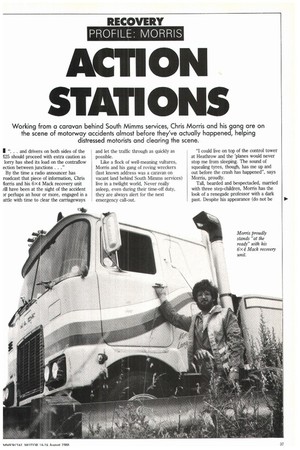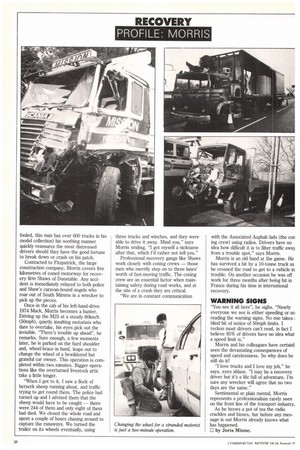ACTION STATIONS
Page 31

Page 32

If you've noticed an error in this article please click here to report it so we can fix it.
Working from a caravan behind South Mimms services, Chris Morris and his gang are on the scene of motorway accidents almost before they've actually happened, helping distressed motorists and clearing the scene.
1 ". . . and drivers on both sides of the 125 should proceed with extra caution as lorry has shed its load on the contrafiow ection between junctions. . ."
By the time a radio announcer has roadcast that piece of information, Chris 4orris and his 6x4 Mack recovery unit rill have been at the sight of the accident r perhaps an hour or more, engaged in a attle with time to clear the carriageways and let the traffic through as quickly as possible.
Like a flock of well-meaning vultures, Morris and his gang of roving wreckers (last known address was a caravan on vacant land behind South Mirnms services) live in a twilight world, Never really asleep, even during their time-off duty, they are always alert for the next emergency call-out. "I could live on top of the control tower at Heathrow and the 'planes would never stop me from sleeping. The sound of squealing tyres, though, has me up and out before the crash has happened", says Morris, proudly.
Tall, bearded and bespectacled, married with three step-children, Morris has the look of a renegade professor with a dark past. Despite his appearance (do not be fooled, this man has over 600 trucks in his model collection) his soothing manner quickly reassures the most distressed drivers should they have the good fortune to break down or crash on his patch.
Contracted to Fitzpatrick, the large construction company, Morris covers five kilometres of coned motorway for recovery firm Shaws of Dunstable. Any accident is immediately relayed to both police and Shaw's caravan-bound angels who roar out of South Mimms in a wrecker to pick up the pieces.
Once in the cab of his left-hand-drive 1974 Mack, Morris becomes a hunter. Driving up the M25 at a steady 80km/h (50mph), quietly insulting motorists who dare to overtake, his eyes pick out the invisible. "There's trouble up ahead", he remarks. Sure enough, a few moments later, he is parked on the hard shoulder and, wheel-brace in hand, leaps out to change the wheel of a bewildered but grateful car owner. This operation is completed within two minutes. Bigger operations like the overturned livestock artic take a little longer.
"When I got to it, I saw a flock of berserk sheep running about, and traffic trying to get round them. The police had turned up and I advised them that the sheep would have to be caught — there were 244 of them and only eight of them had died. We closed the whole road and spent a couple of hours chasing around to capture the runaways. We turned the trailer on its wheels eventually, using three trucks and winches, and they were able to drive it away. Mind you," says Morris smiling, "I got myself a nickname after that, which I'd rather not tell you."
Professional recovery gangs like Shaws work closely with coning crews — those men who merrily step on to three lanes' worth of fast-moving traffic. The coning crew are an essential factor when maintaining safety during road works, and at the site of a crash they are critical.
"We are in constant communication with the Associated Asphalt lads (the con ing crew) using radios. Drivers have no idea how difficult it is to filter traffic away from a trouble spot," says Morris.
Morris is an old hand at the game. He has survived a hit by a 10-tonne truck as he crossed the road to get to a vehicle in trouble. On another occasion he was off work for three months after being hit in France during his time in international recovery.
WARNING SIGNS
"You see it all here", he sighs. "Nearly everyone we see is either speeding or no reading the warning signs. No one takes ; blind bit of notice of 50mph limits. I reckon most drivers can't read, in fact I believe 95% of drivers have no idea what a speed limit is."
Morris and his colleagues have certainl; seen the devastating consequences of speed and carelessness. So why does he still do it?
"I love trucks and I love my job," he says, eyes ablaze. "I may be a recovery driver but its a life full of adventure. I'm sure any wrecker will agree that no two days are the same."
Sentimental or plain mental, Morris represents a professionalism rarely seen on the front line of the transport industry.
As he brews a pot of tea the radio crackles and hisses, but before any message is out Morris already knows what has happened.
El by Joris Minne.










































